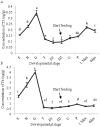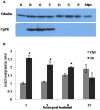Identification of Thyroid Hormones and Functional Characterization of Thyroid Hormone Receptor in the Pacific Oyster Crassostrea gigas Provide Insight into Evolution of the Thyroid Hormone System
- PMID: 26710071
- PMCID: PMC4692385
- DOI: 10.1371/journal.pone.0144991
Identification of Thyroid Hormones and Functional Characterization of Thyroid Hormone Receptor in the Pacific Oyster Crassostrea gigas Provide Insight into Evolution of the Thyroid Hormone System
Abstract
Thyroid hormones (THs) play important roles in development, metamorphosis, and metabolism in vertebrates. During the past century, TH functions were regarded as a synapomorphy of vertebrates. More recently, accumulating evidence has gradually convinced us that TH functions also occur in invertebrate chordates. To date, however, TH-related studies in non-chordate invertebrates have been limited. In this study, THs were qualitatively detected by two reliable methods (HPLC and LC/MS) in a well-studied molluscan species, the Pacific oyster Crassostrea gigas. Quantitative measurement of THs during the development of C. gigas showed high TH contents during embryogenesis and that oyster embryos may synthesize THs endogenously. As a first step in elucidating the TH signaling cascade, an ortholog of vertebrate TH receptor (TR), the most critical gene mediating TH effects, was cloned in C. gigas. The sequence of CgTR has conserved DNA-binding and ligand-binding domains that normally characterize these receptors. Experimental results demonstrated that CgTR can repress gene expression through binding to promoters of target genes and can interact with oyster retinoid X receptor. Moreover, CgTR mRNA expression was activated by T4 and the transcriptional activity of CgTR promoter was repressed by unliganded CgTR protein. An atypical thyroid hormone response element (CgDR5) was found in the promoter of CgTR, which was verified by electrophoretic mobility shift assay (EMSA). These results indicated that some of the CgTR function is conserved. However, the EMSA assay showed that DNA binding specificity of CgTR was different from that of the vertebrate TR and experiments with two dual-luciferase reporter systems indicated that l-thyroxine, 3,3',5-triiodothyronine, and triiodothyroacetic acid failed to activate the transcriptional activity of CgTR. This is the first study to functionally characterize TR in mollusks. The presence of THs and the functions of CgTR in mollusks contribute to better understanding of the evolution of the TH system.
Conflict of interest statement
Figures







Similar articles
-
Evolution of ligands, receptors and metabolizing enzymes of thyroid signaling.Mol Cell Endocrinol. 2017 Dec 25;459:5-13. doi: 10.1016/j.mce.2017.03.021. Epub 2017 Mar 22. Mol Cell Endocrinol. 2017. PMID: 28342854 Review.
-
Functional characterization of retinoid X receptor with an emphasis on the mediation of organotin poisoning in the Pacific oyster (Crassostrea gigas).Gene. 2020 Aug 30;753:144780. doi: 10.1016/j.gene.2020.144780. Epub 2020 May 18. Gene. 2020. PMID: 32439374
-
Non-mammalian models reveal the role of alternative ligands for thyroid hormone receptors.Mol Cell Endocrinol. 2017 Dec 25;459:59-63. doi: 10.1016/j.mce.2017.03.003. Epub 2017 Mar 4. Mol Cell Endocrinol. 2017. PMID: 28267601 Review.
-
Active metabolism of thyroid hormone during metamorphosis of amphioxus.Integr Comp Biol. 2010 Jul;50(1):63-74. doi: 10.1093/icb/icq052. Epub 2010 May 24. Integr Comp Biol. 2010. PMID: 21558188
-
Regulation of thyroid hormone sensitivity by differential expression of the thyroid hormone receptor during Xenopus metamorphosis.Genes Cells. 2012 Aug;17(8):645-59. doi: 10.1111/j.1365-2443.2012.01614.x. Epub 2012 Jun 12. Genes Cells. 2012. PMID: 22686326
Cited by
-
Thyroid hormones reversibly inhibit metamorphic development in ophiuroid larvae.J Exp Biol. 2025 Feb 1;228(3):JEB249351. doi: 10.1242/jeb.249351. Epub 2025 Feb 12. J Exp Biol. 2025. PMID: 39760280 Free PMC article.
-
Thyroid hormone receptor localization in target tissues.J Endocrinol. 2018 Apr;237(1):R19-R34. doi: 10.1530/JOE-17-0708. Epub 2018 Feb 12. J Endocrinol. 2018. PMID: 29440347 Free PMC article. Review.
-
Proteome of larval metamorphosis induced by epinephrine in the Fujian oyster Crassostrea angulata.BMC Genomics. 2020 Sep 29;21(1):675. doi: 10.1186/s12864-020-07066-z. BMC Genomics. 2020. PMID: 32993483 Free PMC article.
-
Larval metamorphosis is inhibited by methimazole and propylthiouracil that reveals possible hormonal action in the mussel Mytilus coruscus.Sci Rep. 2021 Sep 29;11(1):19288. doi: 10.1038/s41598-021-98930-9. Sci Rep. 2021. PMID: 34588587 Free PMC article.
-
Shared regulatory function of non-genomic thyroid hormone signaling in echinoderm skeletogenesis.Evodevo. 2024 Aug 7;15(1):10. doi: 10.1186/s13227-024-00226-2. Evodevo. 2024. PMID: 39113104 Free PMC article.
References
-
- Yen PM. Physiological and molecular basis of thyroid hormone action. Physiol Rev. 2001;81(3):1097–142. ISI:000169570800005. - PubMed
Publication types
MeSH terms
Substances
LinkOut - more resources
Full Text Sources
Other Literature Sources
Research Materials
Miscellaneous

